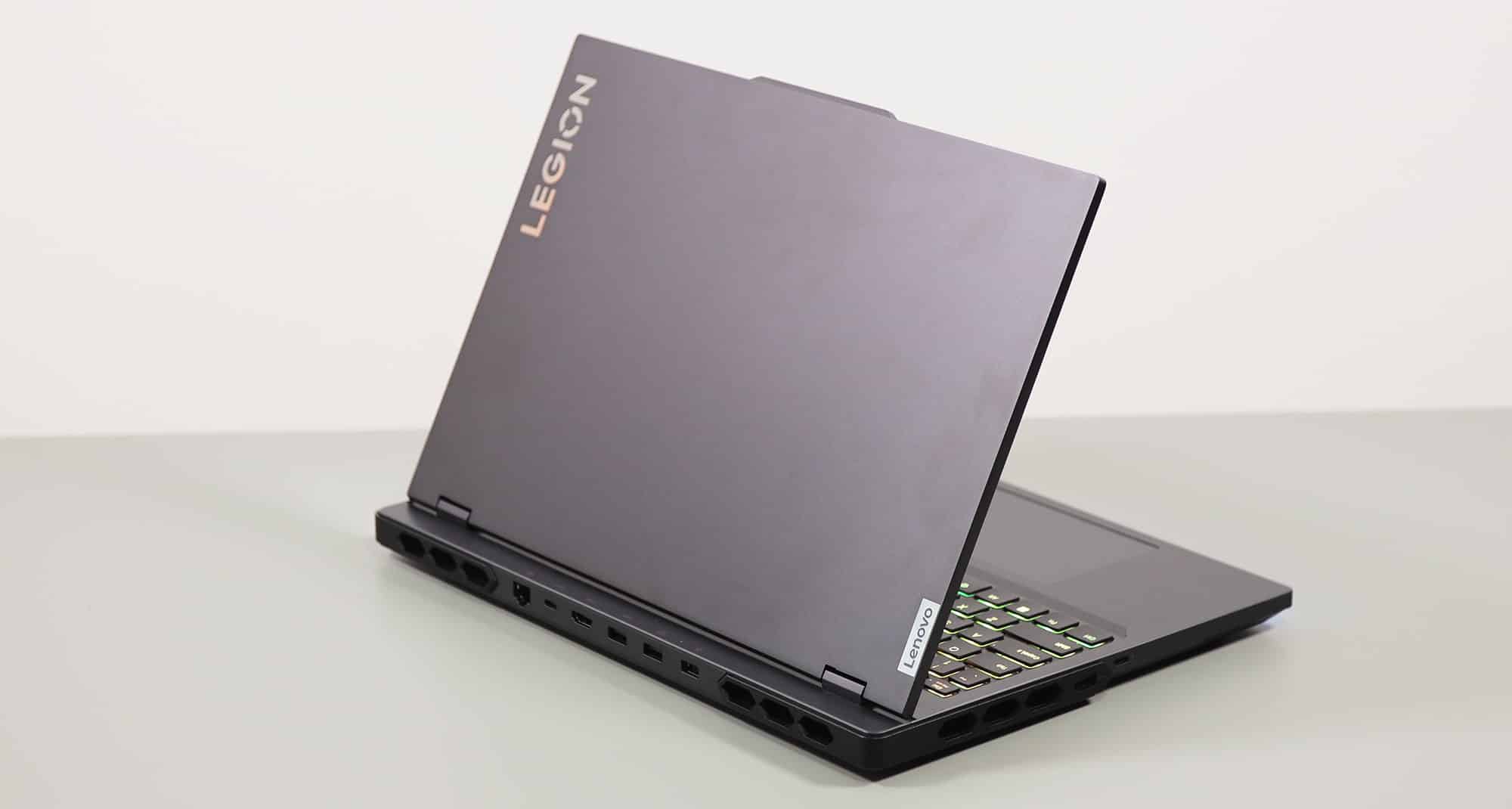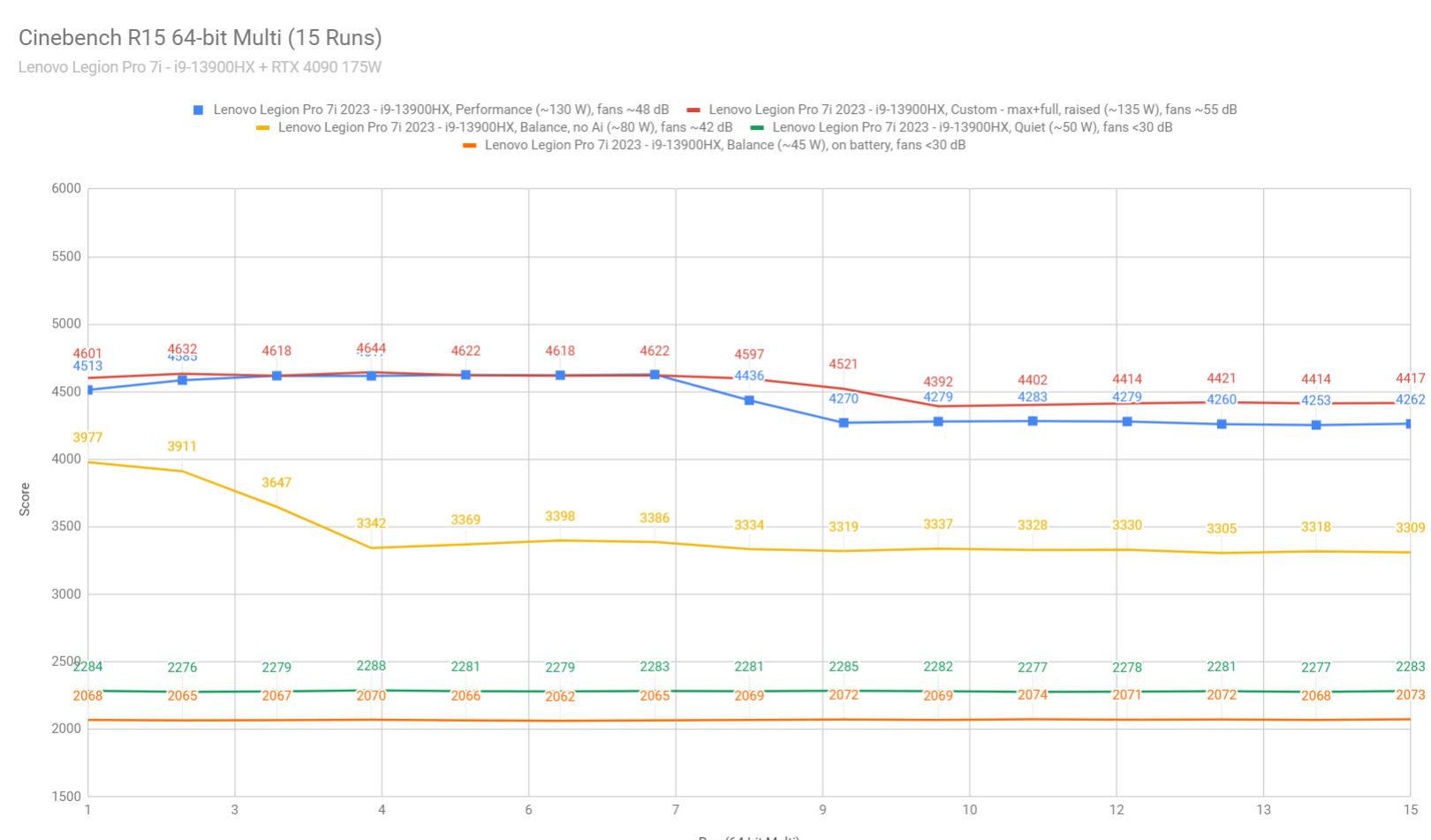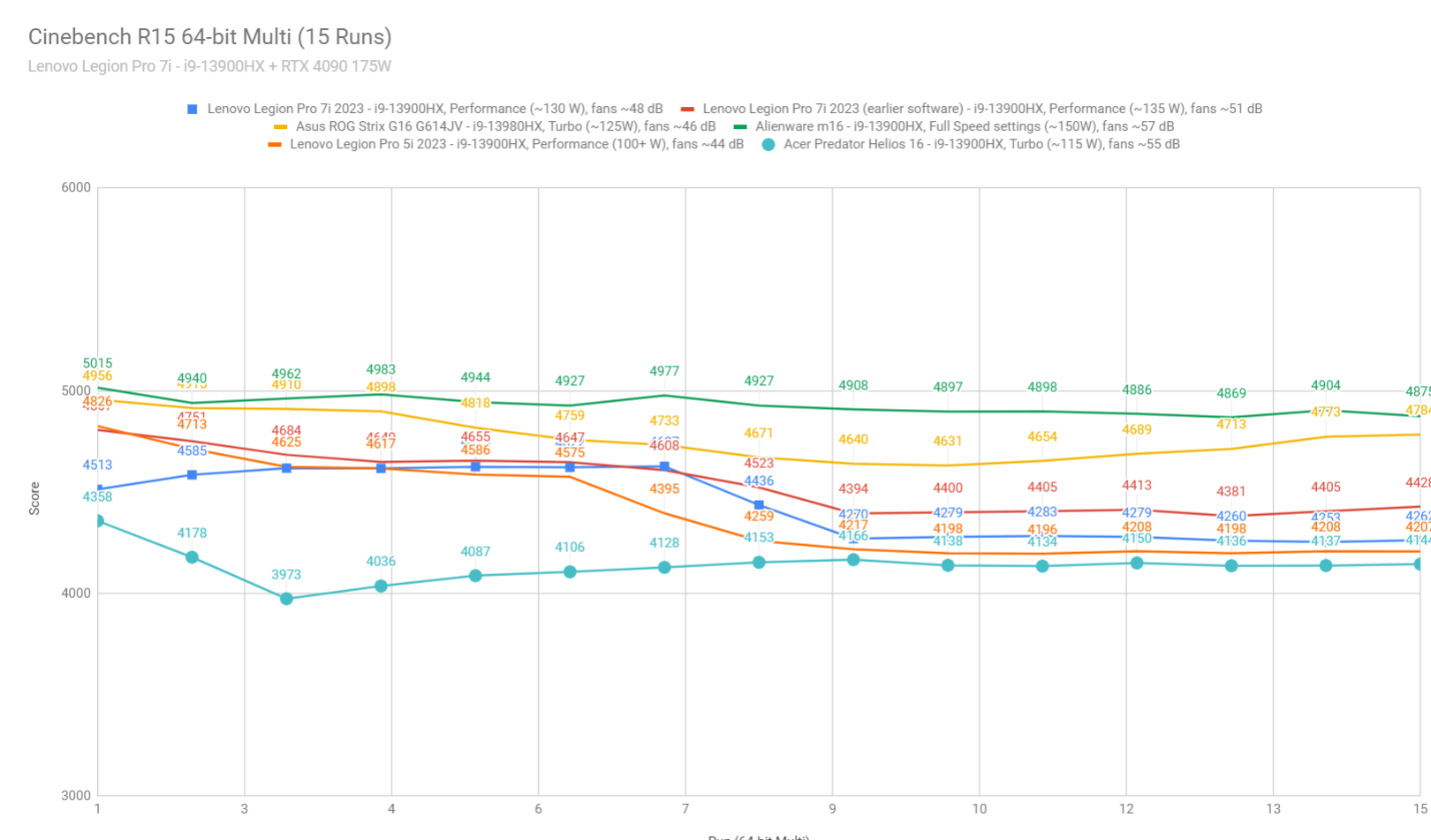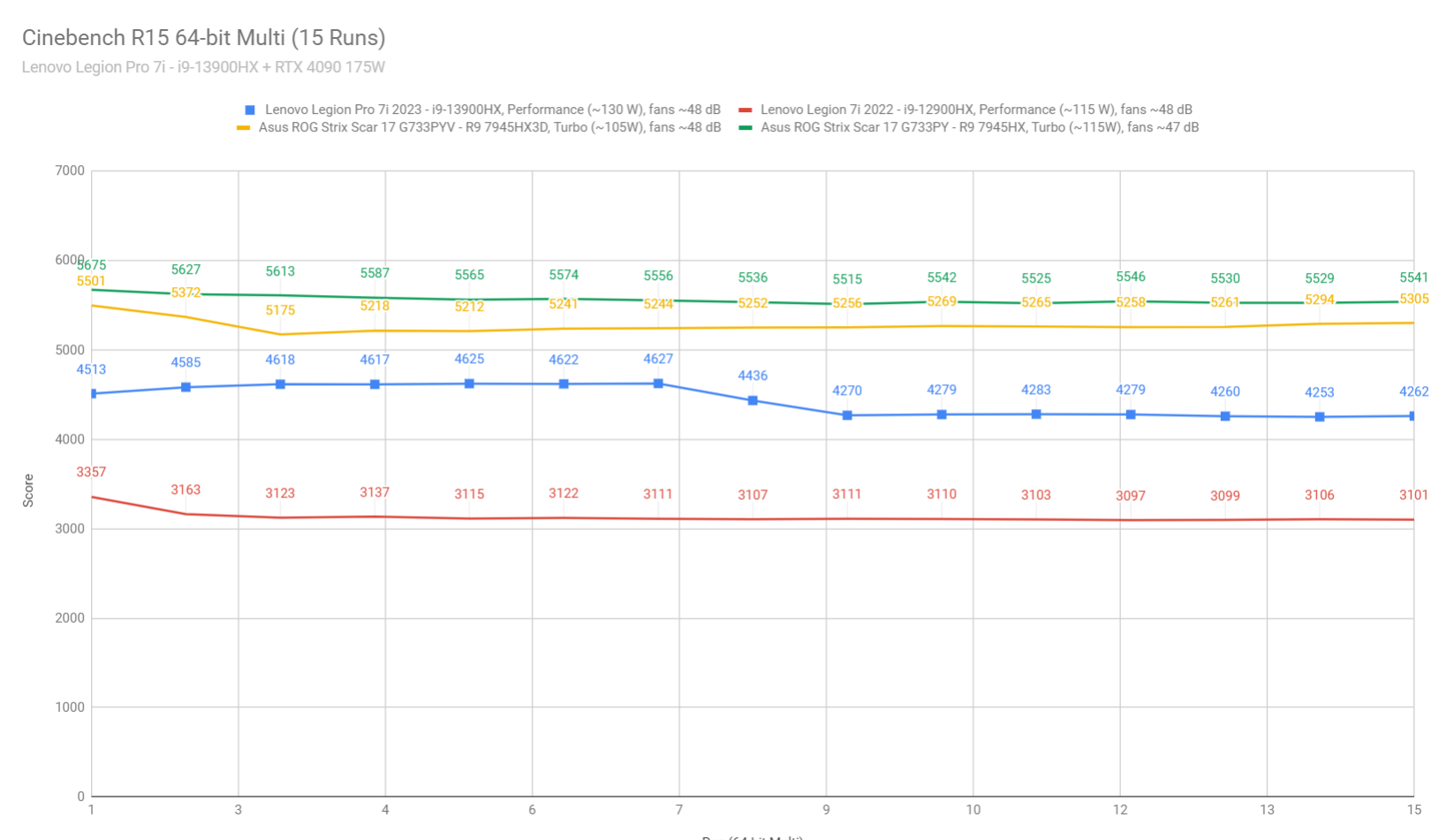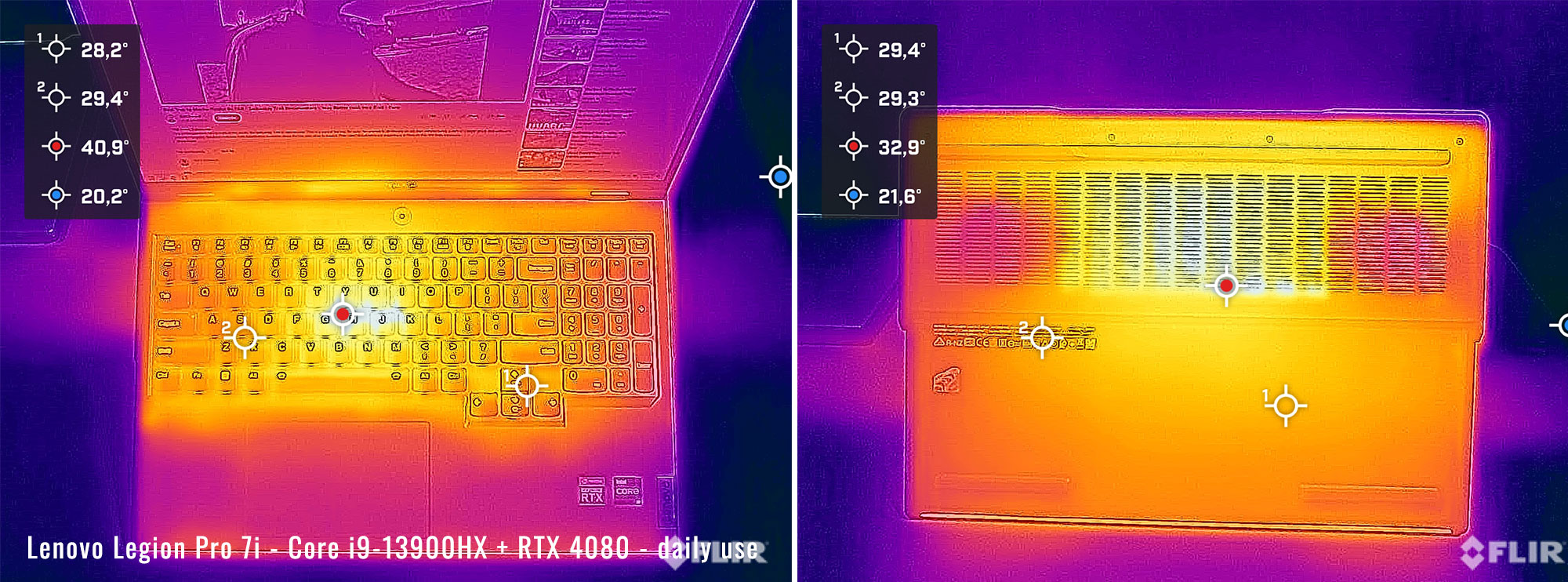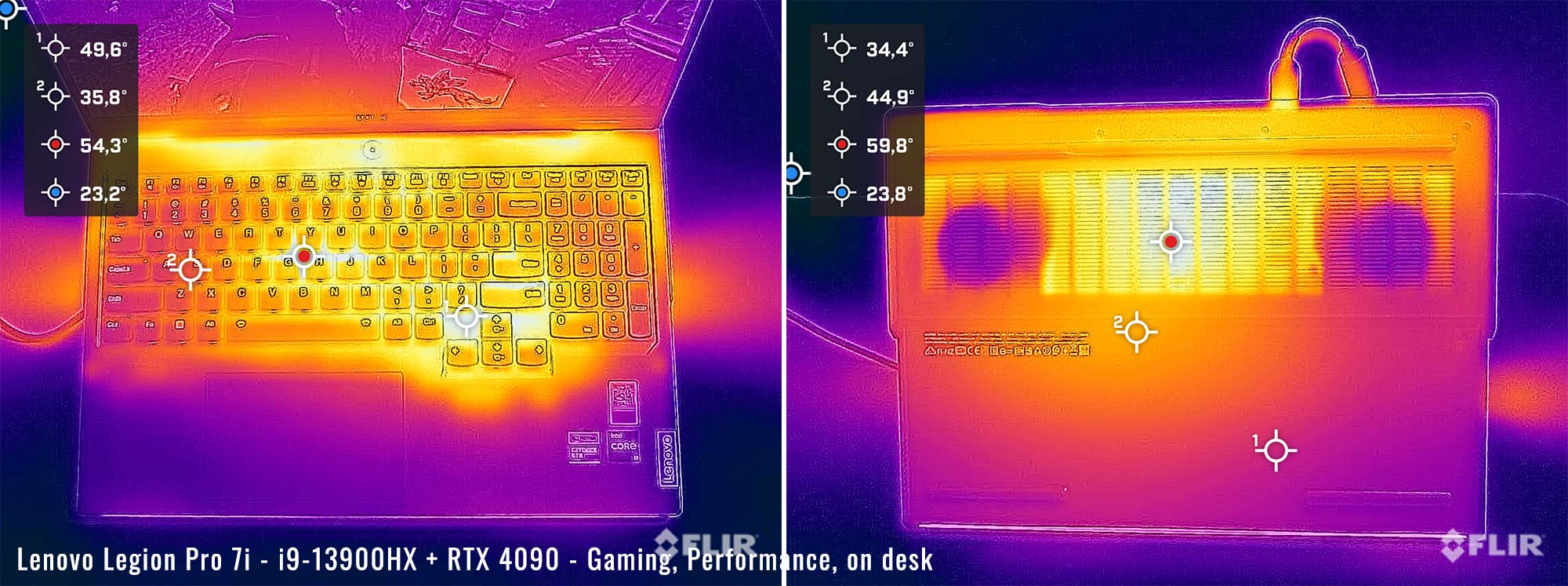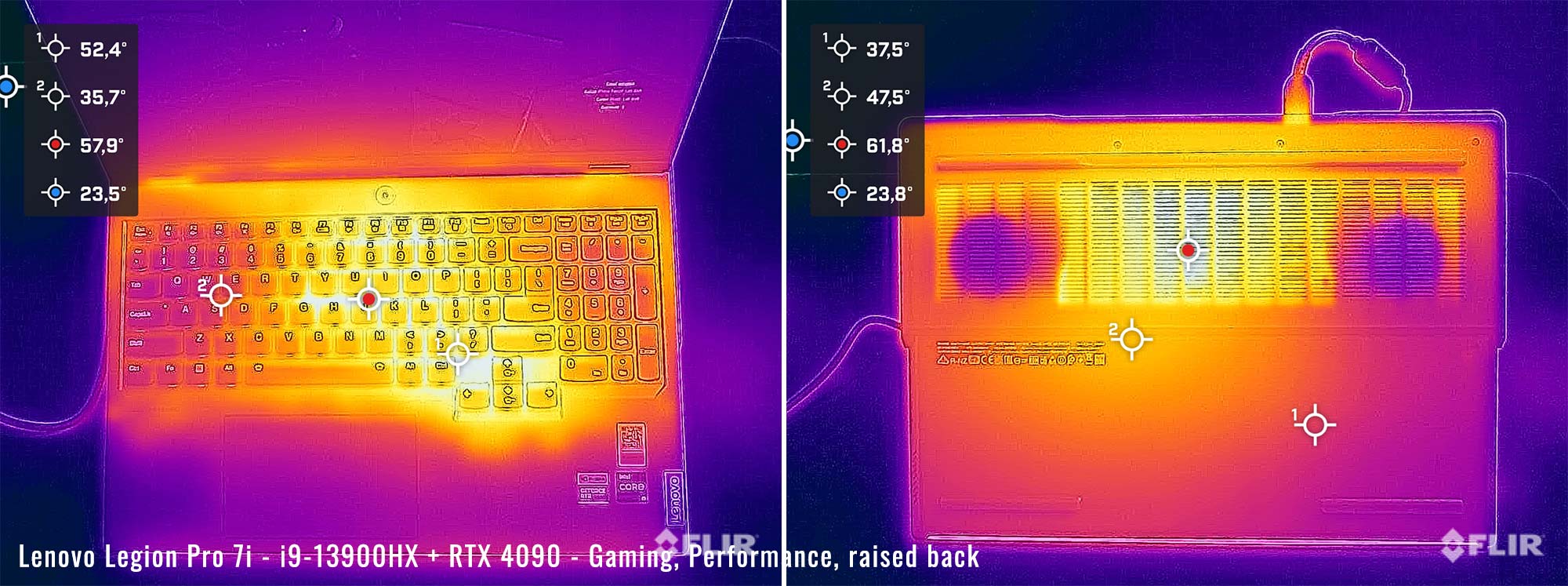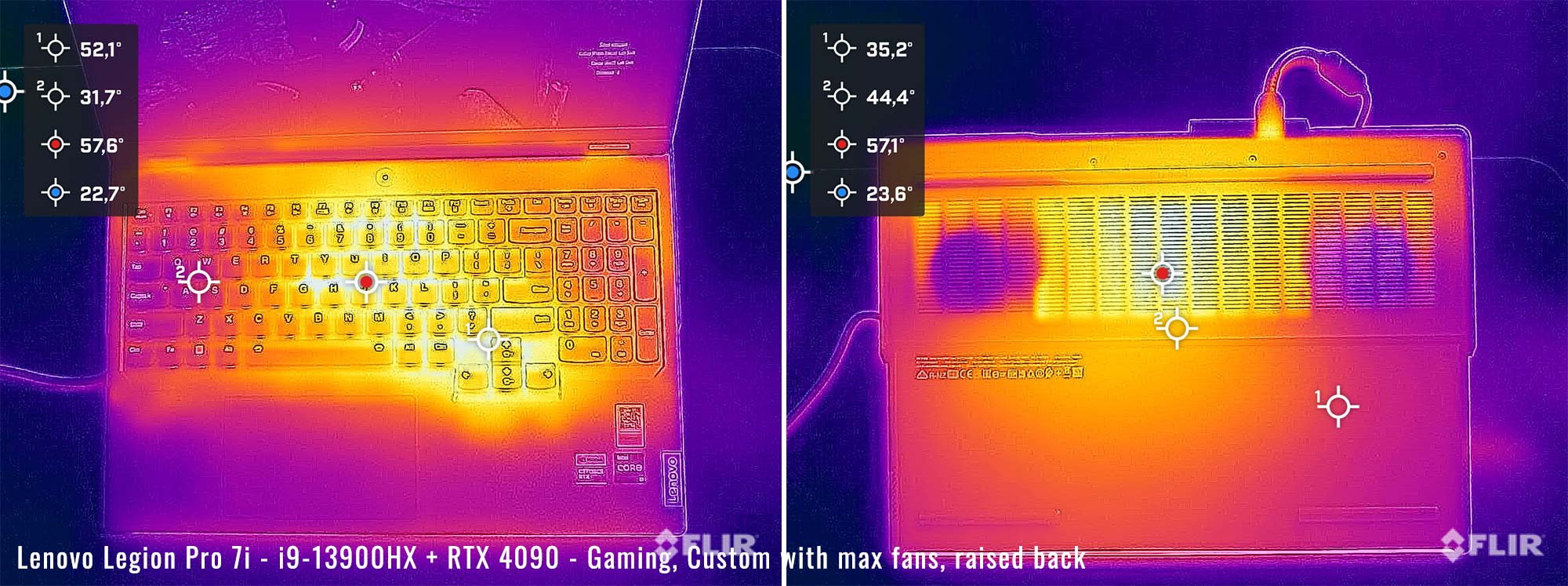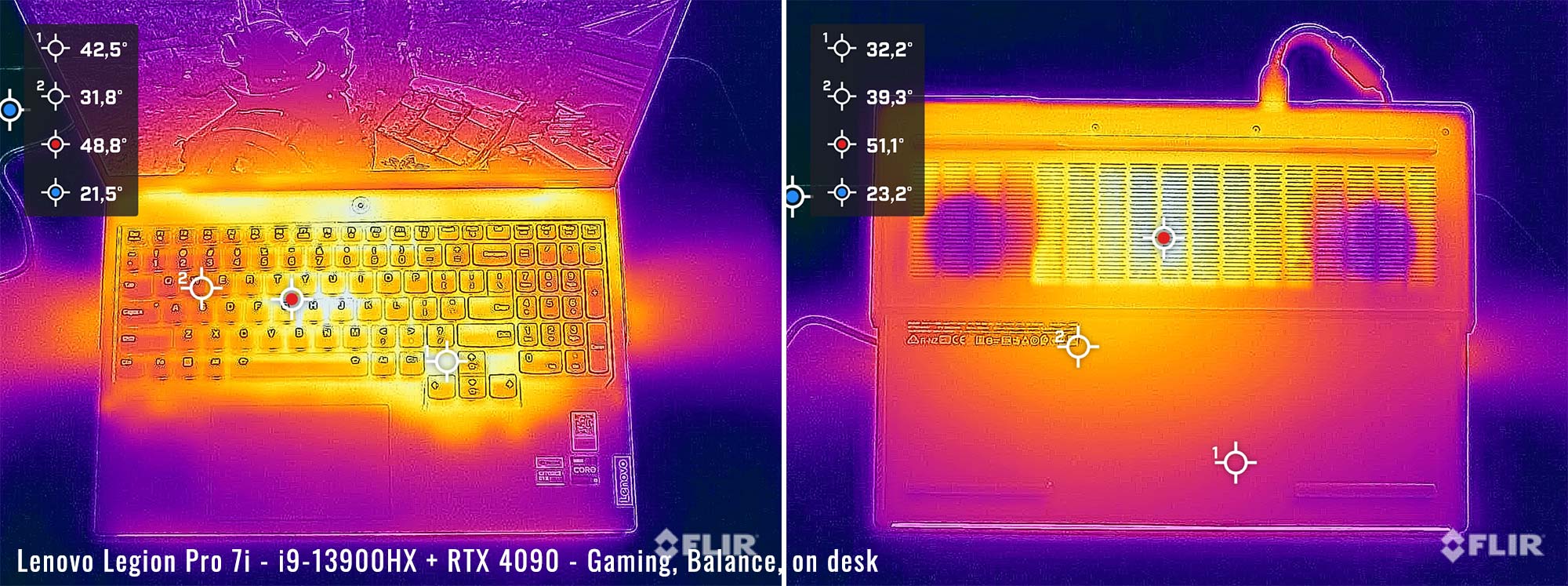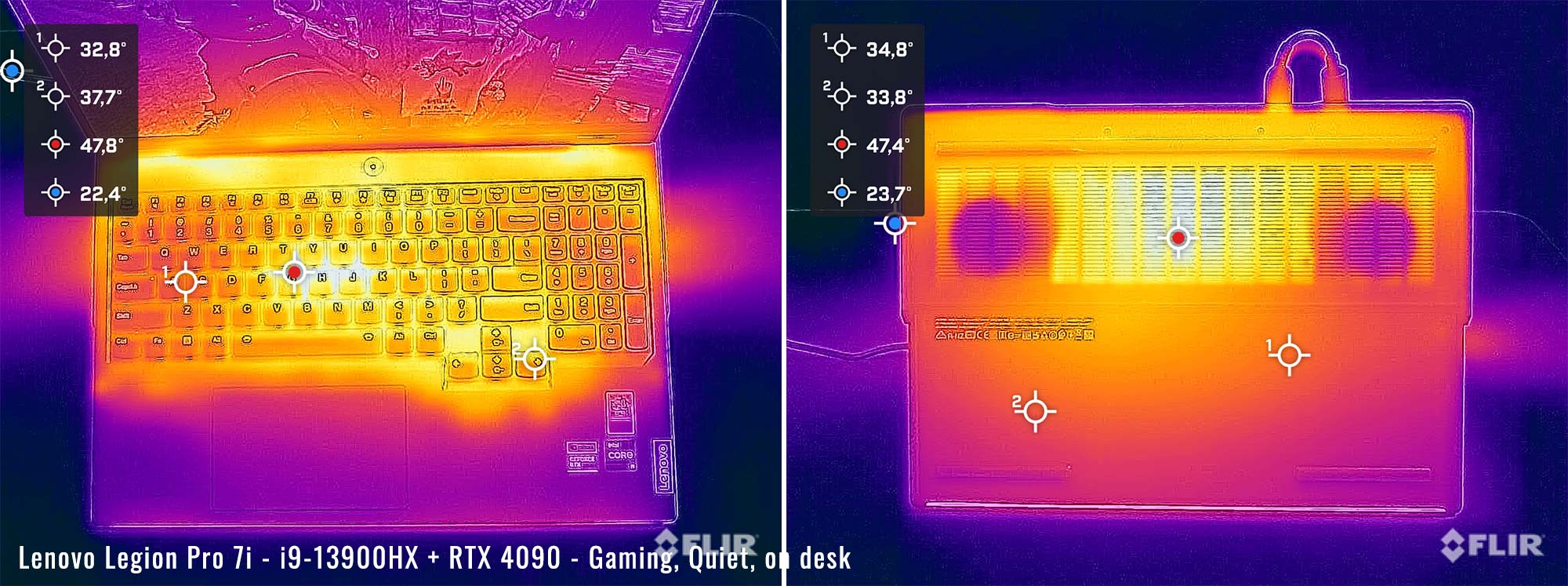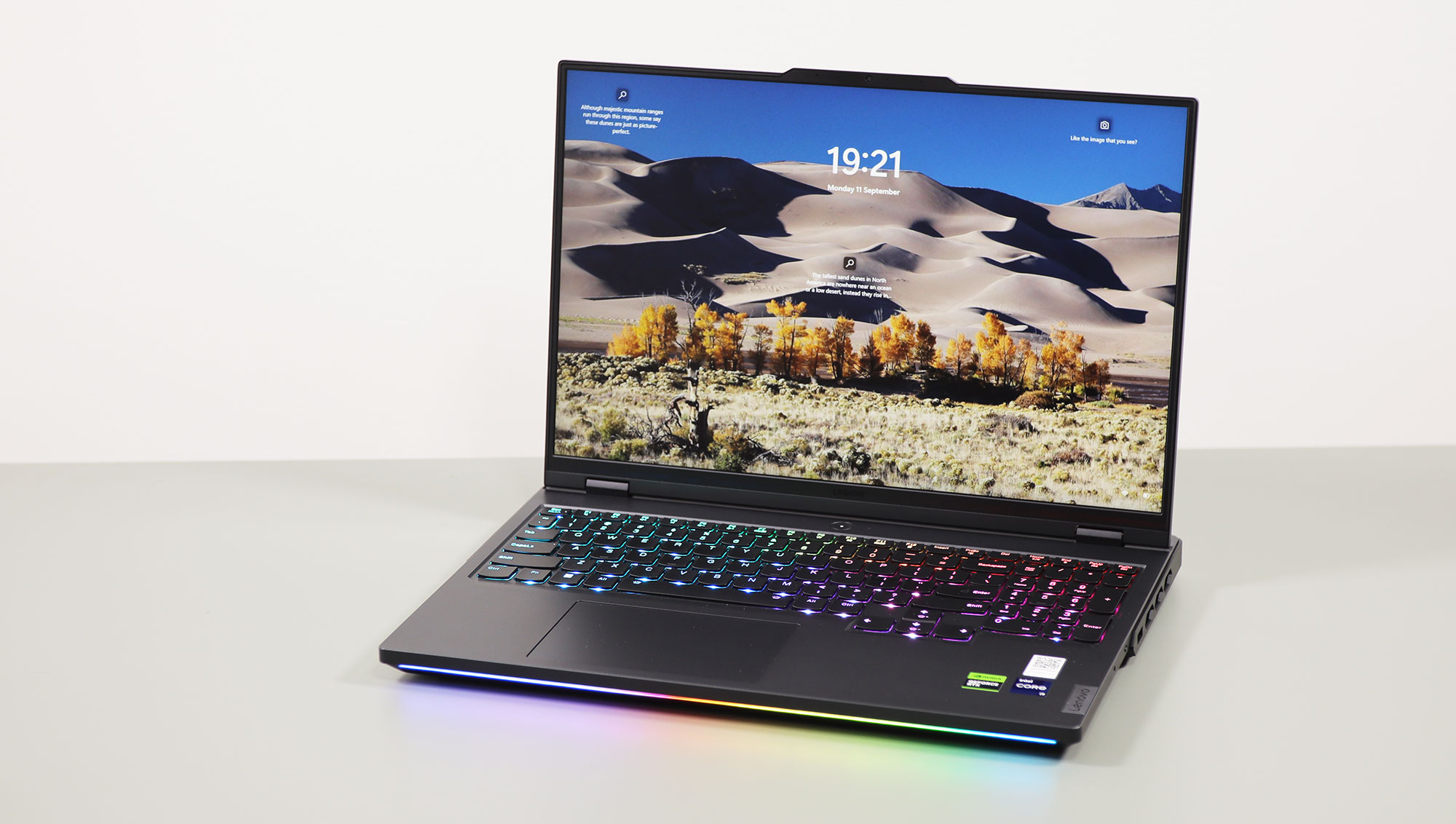This is our detailed review of the highest-tier configuration of the Lenovo Legion Pro 7i series, the 2023 gen8 generation.
This configuration bundles the Intel Core i9-13900HX processor, 32 B RAM, 1 TB of fast SSD storage, and the Nvidia GeForce RTX 4090 16 GB 175W graphics chip. We’ve already reviewed the RTX 4080 variant in a previous article, so we’re mostly going to focus our attention on the performance capabilities of this RTX 4090 model, the differences between the RTX 4090 and 4080 options, as well as on the small software tweaks implemented by Lenovo in the last couple of months since our earlier review.
In a few words, the Legion Pro 7i is a full-size performance and gaming laptop, arguably Lenovo’s most powerful notebook to date, alongside the newer and more portable Legion 9i series.
This 2023 generation is a little heavier and larger than the previous Legion 7 models, as well as slightly more basic in a couple of ways, both aesthetically and functionally. It’s still an all-metal chassis with a 16-inch display, an RGB keyboard, a large battery, and solid ergonomics.
It tends to run rather toasty, though, as a result of implementing higher-power hardware than in the past, but with a similar vapor-chamber cooling module. We’ll touch on this important aspect down below, as well as on everything else that you’ll need to account for when considering this top RTX 4090 configuration of the Lenovo Legion 7i.
Specs as reviewed– 2023 Lenovo Legion Pro 7i Gen 8
| Lenovo Legion Pro 7 16IRX8H (Gen 8, 2023 model year) | |
| Screen | 16 inch, 16:10 format, IPS, matte, 2560×1600 px, 240 Hz, 3ms 500-nits, 100% sRGB |
| Processor | Intel 13th-gen Raptor Lake HX, Core i9-13900HX, 8PC+16Ec/32T |
| Video | Intel UHD + NVIDIA GeForce RTX 4090 with 16GB GDDR6 VRAM 150-175W, with MUX, Advanced Optimus, and GSync |
| Memory | 32 GB DDR5-5600 (2x DIMMs), up to 64 GB |
| Storage | 1 TB PCIe gen4 (Samsung PM9A1) – 2x M.2 2280 PCIe gen4 SSD slots |
| Connectivity | WiFi 6E (Killer 1675i), Bluetooth 5.2, Gigabit Lan |
| Ports | Left: 1x USB-C 3.2 with Thunderbolt 4, 1x USB-A gen1 Right: 1x USB-A 3.2 gen1, 1x audio jack, 1x eShutter button Back: 2x USB-A gen1, 1x USB-C gen2 (DP, power), HDMI 2.1, LAN, DC-In |
| Battery | 99.9 Whr, 330 W GaN power adapter, USB-C charging up to 140W |
| Size | 363.4 mm or 14.33” (w) x 262.2 mm or 10.31 (d) x 21.95 – 25.9 mm or .86″ – 1.02” (h) |
| Weight | 2.65 kg (5.85 lbs) + .95 kg (2.1 lbs) for the charger+cables, EU version |
| Extras | per-key RGB backlit keyboard with NumPad, 1.5 mm travel, plastic clickpad, 2x 2W stereo speakers, FHD webcam with eShutter and Tobii Horizon, no figner-sensor in the power button anymore, available in Space Grey |
This series is available in a multitude of other specs, with either Intel Core i9 HX or AMD Ryzen 9 HX hardware and RTX 4070 to RTX 4090 graphics.
We’ve already reviewed the i9 + RTX 4080 Legion 7i variant in a previous article, and we might cover other configurations in future reviews.
Design, inputs and display
I’ll refer you to our previous article for my thoughts on the design, ergonomics, inputs and the 16-inch display available on this series.
Hardware and performance
Our test model is the top-specced configuration of the 2023 Lenovo Legion Pro 7i, built on an Intel Core i9-13900HX processor, 32 GB of DDR5-5600 memory, 1 TB of fast SSD storage, and dual graphics: the Nvidia RTX 4090 16GB dGPU and the Intel iGPU integrated within the Intel processor.
Disclaimer: This is a retail unit provided for this review by Lenovo, and it runs on the software available as of early-September 2023 (BIOS KWCN37W, Vantage 3.13.43.0, GeForce 537.13 drivers). By this point, this is a mature software package, and very little might still change with later updates.
Spec-wise, the 2023 Legion Pro 7i is built on the latest and most powerful Intel and Nvidia hardware available to date.
The Core i9-13900HX is an Intel Raptor Lake 13th-gen high-performance mobile processor, with 24 Cores and 32 Threads. It is a hybrid design with 8 High-Performance and dual-threaded Cores, and 16 extra Efficiency cores, which work together in the various loads. The design and thermal module of this Legion allow the processor to run at ~130-140W of sustained power in demanding CPU loads.
For the GPU, the 2023 Legion Pro 7i series is available with full-power RTX 4000 graphics chips. This unit is the Nvidia GeForce RTX 4090 16GB running at up to 175W with Dynamic Boost. RTX 4080 12GB 175W and RTX 4070 8GB 150W configurations are available as well.
A MUX is offered here, with Advanced Optimus. The Vantage control app also allows for a couple of working modes such as Hybrid and dGPU-0nly.
For the RAM, the series offers two DDR5 DIMMs. Our unit is a 32 GB of DDR5-5600 RAM (2x 16 GB) configuration.
For storage, there are two M.2 2280 PCIe gen4 slots on this series, and our sample comes preconfigured with a fast gen4 1 TB Samsung PM9A1 drive.
Getting to the components requires you to remove a few Philips screws, all visible around the back panel, and then pull up this D-panel. You might need a plastic pin and some sort of suction cup to pull it out, as it is snugly attached to the main chassis.
Inside, everything is encapsulated, the RAM is covered by a metal shield, and the SSDs and WiFi slot are also covered by thermal radiators. You’ll need to remove those shields in order to access the components.
For the software, this unit came with Windows 11 preinstalled and the standard set of Lenovo apps – you might want to uninstall some of them.
The power profiles are Quiet, Balance, Balance with Legion Ai, and Performance, and you can select them from Vantage or switch between them with Fn+Q. There’s also an advanced Custom mode that allows granular tweaking of various settings and power limits. It’s a welcomed addition for the 2023 Legion generations.
These profiles apply different power settings to the CPU/GPU and different fan profiles, as well as switch the color of the LED in the power button. Here’s a table that shows what each mode does, with the tested BIOS and software packag:
| Quiet (blue) | Balance (white) | Balance + Ai(white) | Performance (red) | Custom (red) | |||||
| TDP PL1/PL2 | TGP | TDP PL1/PL2 | TGP | TDP PL1/PL2 | TGP | TDP PL1/PL2 | TGP | TDP PL1/PL2 | TGP |
| 55/65W | ~50W | 80W/120W | ~80W | – | up to 175W | 130W/185W | up to 175W | 140W/190W | up to 175W |
This series also offers a quick dGPU Overclocking toggle, which applies +100 MHz Core, +200 MHz Memory settings. We’ve used this setting for all our tests, but further tweaking is also possible if you want to.
Before we jump to the performance section, here’s how this laptop handles everyday use and multitasking on the Quiet/Balance profiles, unplugged from the wall.
Performance and benchmarks
On to more demanding loads, we start by testing the CPU’s performance by running the Cinebench R15 test for 15+ times in a loop, with a 1-2 seconds delay between each run.
With the laptop sitting on the desk and on Performance mode, the Core i9-13900HX processor kicks in at ~185 W of peak power, and then stabilizes at ~130W of sustained power. The CPU is power-limited, as the cores’ temperatures stabilize at around 82-85 degrees Celsius, so in theory this implementation could allow for slightly higher sustained power.
Maxing out the settings in the Custom mode and raising the laptop on a stand in order to favor airflow into the bottom-placed fans merely impacts the sustained performance by ~5%, as the sustained power stabilizes at around 150W, with CPU temperatures around 86-88 C. However, the fans also run much louder in this mode, at 55 dBA vs 48 dBA on Performance.
Switching over to the Balance profile (without Legion AI) translates into the CPU being power capped at ~80W sustained. The fans run significantly quieter, and the internal temperatures drop to sub 70s C. The performance takes a 30% dip as well with this sort of power limit.
The Quiet profile keeps the fans at sub 30 dBA, with an aggressive power limit of around 50W sustained, which translates in ~50% of the performance of the top profiles.
Finally, the CPU runs at 45 W of sustained power on battery, on the Balance profile. Details below.
Overall, these profiles are well polished, and quite conservative, I might add. Strict power limits on Performance/Balance/Quiet ensure that the laptop is never thermally limited in any sustained load, and there’s a good variation of noise/power between the available settings. The Custom profile allows for higher sustained power than the other two, but even this one caps the PL2 sustained limit to around 140W in our tests.
To put these findings in perspective, here’s how this Core i9-13900HX implementation fares against other modern performance laptops in this test.
The Legion Pro 7i is a balanced performer, within 10% of the fastest Raptor Lake Core i9 13950HX implementations that are running at higher sustained power, and a little faster than some other implementations that run at lower sustained power.
On the other hand, this 2023 Legion Pro 7i generation is a massive step up in performance over the previous 2022 Legion 7i (i7-12900HX variant).
Furthermore, you should expect the AMD Ryzen 9 HX variant of the Legion Pro 7 to outmatch the Intel model in this sort of CPU heavy sustained load. I haven’t tested that yet, but I’ve added two Ryzen 9 7945HX and 7945HX3D configuration for comparison.
With these out of the way, we went ahead and further verified our findings with the more taxing Cinebench R23 loop test and Blender – Classroom, which resulted in similar findings to those explained above.
We also ran the 3DMark CPU test on the Performance profile.
Finally, we ran our combined CPU+GPU stress tests on this notebook. 3DMark stress runs the same test for 20 times in a loop and looks for performance variation and degradation over time, and this unit passed it just fine (both when kept flat on the desk or when placed on a raiser stand), which means there’s no performance throttling with longer-duration sustained loads.
Next, we ran the entire suite of tests and benchmarks, on the Performance profile with the GPU set on the Hybrid mode (MUX on Advanced Optimus), and with the screen set at the native QHD+ resolution.
Here’s what we got:
- 3DMark 13 – CPU profile: max – 12754, 16 – 9773, 8 – 7854, 4 – 4312, 2 – 2248, 1 – 1138;
- 3DMark 13 – Fire Strike (DX11): 35744 (Graphics – 47175, Physics – 38696, Combined – 11193);
- 3DMark 13 – Port Royal (RTX): 14063;
- 3DMark 13 – Time Spy (DX12): 20953 (Graphics – 21882, CPU – 16890);
- 3DMark 13 – Speed Way (DX12 Ultimate): 5670;
- Uniengine Superposition – 1080p Extreme: 13700;
- Uniengine Superposition – 1080p Medium: 37720;
- Handbrake 1.3.3 (4K to 1080p encode): 80.07 average fps;
- Handbrake 1.6.1 (4K to 1080p encode): 118.15 average fps;
- PCMark 10: 7914 (Essentials – 11449, Productivity – 11284, Digital Content Creation – 10414);
- GeekBench 5.5.1 64-bit: Multi-core: 20719, Single-Core: 2031;
- GeekBench 6.0.2: Multi-core: 17045, Single-Core: 2704;
- CineBench R15 (best run): CPU 4541 cb, CPU Single Core 293 cb;
- CineBench R20 (best run): CPU 11304 cb, CPU Single Core 766 cb;
- CineBench R23: CPU 29549 cb (best single run), CPU 27352 cb (10 min run), CPU Single Core 1988 cb;
- x265 HD Benchmark 64-bit: 19.94 s.
And here are some workstation benchmarks, on the same Turbo profile:
- Blender 3.01 – BMW scene – CPU Compute: 1m 22s ;
- Blender 3.01 – BMW scene – GPU Compute: 10.23s (CUDA), 5.93s (Optix);
- Blender 3.01 – Classroom scene – CPU Compute: 3m 21s;
- Blender 3.01 – Classroom scene – GPU Compute: 19.43s (CUDA), 12.97s (Optix);
- Blender 3.41 – BMW scene – CPU Compute: 1m 20s;
- Blender 3.41 – BMW scene – GPU Compute: 9.91s (CUDA), 5.19 (Optix);
- Blender 3.41 – Classroom scene – CPU Compute: 3m 24s;
- Blender 3.41 – Classroom scene – GPU Compute: 17.33s (CUDA), 9.84s (Optix);
- PugetBench – DaVinci Resolve: 1990 points;
- PugetBench – Adobe After Effects: 1136;
- PugetBench – Adobe Photoshop: 1213;
- PugetBench – Adobe Premiere: 901;
- SPECviewperf 2020 – 3DSMax: 199.64;
- SPECviewperf 2020 – Catia: 111.44;
- SPECviewperf 2020 – Creo: 131.98;
- SPECviewperf 2020 – Energy: 76.60;
- SPECviewperf 2020 – Maya: 542.53;
- SPECviewperf 2020 – Medical: 56.62;
- SPECviewperf 2020 – SNX: 36.87;
- SPECviewperf 2020 – SW: 450.31.
- V-Ray Benchmark: 20174 – CPU, 2673 – CUDA, 3558 – RTX.
This is one of the fastest laptops we’ve tested this year and will handle everything smoothly, from daily multitasking to heavy workloads and gaming sessions.
On the CPU side, sure, there are some implementations of the i9-13980HX processor running at higher power, which can push up to 5% higher scores in benchmarks. And there are also the AMD Ryzen 9 7945HX implementations, which are as much as 20% faster in multi-threaded loads, but not as fast in single-core loads. So if raw CPU power is what you’re after, this Legion Pro 7i is not quite the best out there. But is darn close.
On the GPU side, this is on par with other RTX 4090 laptops we’ve tested before, within the margin of error. However, what will make a differences are internal and external temperatures, which we’re discussing in a bit.
RTX 4090 vs. RTX 4080 vs. RTX 4070, in 2023 Legion Pro units
But first, here’s how this test unit fares in a few tests next to the i9 HX + RTX 4080 configuration tested earlier, as well as next to the i9 HX + RTX 4070 variant of the mid-tier Lenovo Legion Pro 5i series.
| i9-13900HX + 4090 175W 2023 Legion Pro 7i |
i9-13900HX + 4080 175W 2023 Legion Pro 7i |
i9-13900HX + 4070 150W 2023 Legion Pro 5i |
|
| 3DMark – Fire Strike | 35744 (G – 47175, P – 38696, C – 11193) | 31551 (G – 40636, P – 37173, C – 10867) | 26433 (G – 29679, P– 39431) |
| 3DMark – Port Royal | 14063 | 12211 | 7860 |
| 3DMark – Time Spy | 20953 (Graphics – 21882, CPU – 16890) | 18781 (Graphics – 19578, CPU – 15262) | 13493 (Graphics – 13102, CPU – 16247) |
| Uniengine Superposition – 1080p Extreme | 13700 | 10718 | 7187 |
| CineBench R23 (best run) | 29549 cb – multi core, 1988 cb – single core |
30747 cb – multi core, 2045 cb – single core |
30176 cb – multi core, 2005 cb – single core |
| Blender 3.01 – Classroom scene – CPU Compute | 3m 21s | 3m 31s | – |
| Blender 3.01 – Classroom scene – GPU Compute | 19.43s (CUDA), 12.97s (Optix) | 24.06s (CUDA), 15.32s (Optix) | – |
| PugetBench – Adobe Photoshop | 1213 | 1172 | – |
| PugetBench – DaVinci After Effects | 1990 | 1850 | – |
| SPECviewperf 2020 – 3DSMax: | 199.64 | 180.38 | 96.46 |
| SPECviewperf 2020 – Catia: | 111.44 | 104.06 | 68.95 |
| SPECviewperf 2020 – Maya: | 542.53 | 563.95 | 405.08 |
Keep in mind that the 4080 Pro 7i and the 4070 Pro 5i are running on early software, so there might be a slight room for improvement on those results. The 4090 Pro 7i, on the other hand, is running on mature software.
That being said, the CPU performance is more or less identical between these units, with an advantage for the Legion Pro 7i models in long sustained loads, due to their superior thermal module that allows for higher sustained power.
On the GPU side, the RTX 4090 is 10-20% faster than the 4080 in the synthetic tests, and the gap shrinks in the real-life workloads. Blender is an exception, where the 4090 keeps a notable advantage over the 4080.
On the other hand, the 4070, which is also an option for the lower-tier Legion Pro 7i models, is significantly slower than the 4080/4090 configurations. Both in benchmarks and in workloads. You should keep these differences in mind when considering that configuration option.
Custom, Balance, Quiet modes
Let’s also touch on the Custom, Balance and Quiet profiles offered in Vantage.
Here’s how this 2023 Legion Pro 7i performs on the Custom profile, with the highest possible power settings and fans set to 100% rpms (which translates in 55+ dBA at head level).
- 3DMark 13 – Fire Strike: 35309 (Graphics – 46436, Physics – 38438, Combined – 12096);
- 3DMark 13 – Time Spy: 21580 (Graphics – 22500, CPU – 17521);
- Uniengine Superposition – 1080p Extreme: 13905;
- CineBench R20 (best run): CPU 10884 cb, CPU Single Core 759 CB;
- Blender 3.41 – Classroom scene – CPU Compute: 3m 23s.
So you’re squeezing 1-4% higher scores in some tests on this Custom profile, but that’s hardly worth it for the notable increase in fan noise. However, it’s worth noting that this mode does have an impact on internal and external temperatures, as you’ll see further down in the gaming section. For the most part, though, I’d hardly use these settings on the Legion 7i.
Next, if you’re willing to sacrifice the performance to some extent to keep the fans quieter than on Performance (~50 dBA), the Balance and Quiet profiles should be of interest.
Here’s how this 2023 Legion Pro 7i performs on the Balance profile, which limits the fans to around 42 dB at head level.
- 3DMark 13 – Fire Strike: 31818 (Graphics – 40344, Physics – 36439, Combined – 11466);
- 3DMark 13 – Time Spy: 15861 (Graphics – 15718, CPU – 16728);
- Uniengine Superposition – 1080p Extreme: 10367;
- CineBench R20 (best run): CPU 9924 cb, CPU Single Core 764 CB;
- Blender 3.41 – Classroom scene – CPU Compute: 4m 24s.
In shorter tests, the CPU runs at about 80-85% of its capabilities in the Performance mode. However, the gap spreads towards 30% in longer sustained CPU loads, where the TDP power cap of 80W kicks in for this Balance mode.
The GPU runs at about 70-80% of its Turbo mode performance, a this is also power limited to around 80W.
You can also opt for the Quiet profile, in which case the fans won’t go over 35 dB. Here’s what we got in this case:
- 3DMark 13 – Fire Strike: 17994 (Graphics – 26558, Physics – 19059, Combined – 5138);
- 3DMark 13 – Time Spy: 11543 (Graphics – 11814, CPU – 10217);
- Uniengine Superposition – 1080p Extreme: 6401;
- CineBench R20 (best run): CPU 5674 cb, CPU Single Core 701 CB;
- Blender 3.41 – Classroom scene – CPU Compute: 6m 24s.
Both the CPU and the GPU are aggressively limited in this mode, due to the power limitations applied by the profile.
They run at roughly 45-55% of their abilities in Performance mode, with the current software. Looks like Lenovo tweaked the Quiet profile in the last months, but for the most part, this mode is still designed for daily multitasking and light use, and not for demanding activities.
Gaming performance
Let’s see how this top-tier configuration of the Lenovo Legion Pro 7i handles modern games.
We tested a couple of different types of games on the various available profiles at QHD+ and FHD+ resolution, all with the MUX manually set on the dGPU mode and the GPU on the Overclocked mode.
Here are the results:
| Core i9-13900HX + RTX 4090 Laptop 150-175W |
QHD+ Performance, dGPU, on desk |
QHD+ Balance, dGPU, on desk |
FHD+ Performance, dGPU, on desk |
FHD+ Quiet, dGPU, on desk |
| Cyberpunk 2077 (DX 12, Ultra Preset, RTX OFF) |
98 fps (68 fps – 1% low) | 69 fps (46 fps – 1% low) | 135 fps (106 fps – 1% low) | 65 fps (37 fps – 1% low) |
| Doom Eternal (Vulkan, Ultra Preset) |
346 fps (81 fps – 1% low) | 244 fps (45 fps – 1% low) | 448 fps (132 fps – 1% low) | 212 fps (126 fps – 1% low) |
| Far Cry 6 (DX 12, Ultra Preset, TAA) |
125 fps (88 fps – 1% low) | 97 fps (75 fps – 1% low) | 122 fps (94 fps – 1% low) | 67 fps (48 fps – 1% low) |
| Far Cry 5 (DX 11, Ultra Preset, SMAA) |
152 fps (106 fps – 1% low) | 111 fps (48 fps – 1% low) | 165 fps (110 fps – 1% low) | 88 fps (56 fps – 1% low) |
| Metro Exodus (DX 12, Ultra Preset, RTX OFF) |
114 fps (67 fps – 1% low) | — | 131 fps (72 fps – 1% low) | – |
| Red Dead Redemption 2 (DX 12, Ultra Optimized, TAA) |
134 fps (47 fps – 1% low) | 108 fps (42 fps – 1% low) | 144 fps (52 fps – 1% low) | 79 fps (38 fps – 1% low) |
| Resident Evil 4 (DX 12, Prioritize Graphics, TAA) |
154 fps (60 fps – 1% low) | 113 fps (45 fps – 1% low) | 192 fps (67 fps – 1% low) | 92 fps (40 fps – 1% low) |
| Shadow of Tomb Raider (DX 12, Highest Preset, TAA) |
162 fps (92 fps – 1% low) | 129 fps (86 fps – 1% low) | 171 fps (94 fps – 1% low) | 67 fps (38 fps – 1% low) |
| The Witcher 3: Wild Hunt (v4.04) (DX 12, Ultra Preset, TAAU) |
133 fps (80 fps – 1% low) | 95 fps (44 fps – 1% low) | 147 fps (79 fps – 1% low) | 106 fps (48 fps – 1% low) |
- Battlefield V, Cyberpunk, Doom, Witcher 3 – recorded with Fraps/in-game FPS counter in campaign mode;
- Far Cry 5, 6, Metro, Red Dead Redemption 2, Tomb Raider – recorded with the included Benchmark utilities;
- Red Dead Redemption 2 Optimized profile based on these settings.
Those above are rasterization tests, and here are some results for RTX – Ray Tracing performance, with and without DLSS.
| Core i9-13900HX + RTX 4090 Laptop 150-175W | QHD+ Performance, dGPU | FHD+ Performance, dGPU |
| Cyberpunk 2077 (DX 12, Ultra Preset + RTX, DLSS3 Off) |
43 fps (30 fps – 1% low) | 67 fps (51 fps – 1% low) |
| Cyberpunk 2077 (DX 12, Ultra Preset + RTX, DLSS3 Balanced) |
128 fps (99 fps – 1% low) | 180 fps (132 fps – 1% low) |
| Doom Eternal (DX 12, Ultra Preset, RTX On, DLSS2 Off) |
245 fps (61 fps – 1% low) | 331 fps (54 fps – 1% low) |
| Doom Eternal (DX 12, Ultra Preset, RTX On, DLSS2 Quality) |
282 fps (656 fps – 1% low) | 376 fps (86 fps – 1% low) |
| Far Cry 6 (DX 12, Ultra Preset + DXR reflections / shadows) |
102 fps (79 fps – 1% low) | 111 fps (82 fps – 1% low) |
| Shadow of Tomb Raider (DX 12, Highest Preset, TAA, RTX Ultra, DLSS2 Off) |
112 fps (68 fps – 1% low) | 134 fps (81 fps – 1% low) |
| Shadow of Tomb Raider (DX 12, Highest Preset, TAA, RTX Ultra, DLSS2 On) |
128 fps (83 fps – 1% low) | 139 fps (88 fps – 1% low) |
| The Witcher 3: Wild Hunt (v4.04 update) (DX 12, RT Ultra Preset, TAAU, DLSS3 Off) |
89 fps (53 fps – 1% low) | 102 fps (59 fps – 1% low) |
| The Witcher 3: Wild Hunt (v4.04 update) (DX 12, RT Ultra Preset, DLSS3 On) |
103 fps (48 fps – 1% low) | 141 fps (94 fps – 1% low) |
This configuration runs smoothly in all these modern games at QHD+ resolution and Ultra settings. RT performance is also impressive for this 4090 variant, especially with DLLS3 in supported titles.
RTX 4090 vs. RTX 4080 gaming performance
Here’s how the RTX 4090 and RTX 4080 configurations fared in a few games, all the screen’s native QHD+ resolution with Ultra settings.
| Legion Pro 7i 2023, Core i9-13900HX + RTX 4090 175W, QHD+ Performance, dGPU, on desk |
Legion Pro 7i 2023, Core i9-13900HX + RTX 4080 175W, QHD+ Performance, dGPU, on desk |
|
| Cyberpunk 2077 (DX 12, Ultra Preset, RTX OFF) |
98 fps (68 fps – 1% low) | 75 fps (45 fps – 1% low) |
| Cyberpunk 2077 (DX 12, Ultra Preset + RTX, DLSS3 Off) |
43 fps (68 fps – 1% low) | 35 fps (68 fps – 1% low) |
| Cyberpunk 2077 (DX 12, Ultra Preset + RTX, DLSS3 Balanced) |
128 fps (68 fps – 1% low) | 110 fps (68 fps – 1% low) |
| Far Cry 6 (DX 12, Ultra Preset, TAA) |
125 fps (88 fps – 1% low) | 120 fps (82 fps – 1% low) |
| Red Dead Redemption 2 (DX 12, Ultra Optimized, TAA) |
134 fps (47 fps – 1% low) | 121 fps (38 fps – 1% low) |
| Shadow of Tomb Raider (DX 12, Highest Preset, TAA) |
162 fps (92 fps – 1% low) | 147 fps (59 fps – 1% low) |
I haven’t included Witcher 3 results in here, because we tested the two models with different versions of the game available at the time (v4.02 update on the 4080, v 4.04 update on the 4090). But you’ll find the results, as long as other gaming tests, in the reviews.
Compared tot he RTX 4080 configuration previously tested, we’re looking at roughly 5-15% gains in framerates at Ultra settings without RT, and around 10-20% with RT settings for the 4090 model. These are inline with our findings in the syntactic tests, and at the end of the day, it’s up to you if these differences are worth the roughly 500 USD/EUR premium that you’ll have to pay for the 4090 configurations over the 4080 units.
With that out of the way, let’s go through some logs.
On this unit, the Performance mode ramps up the fans to levels of ~48 dB with the laptop sitting on the desk. That a little quieter than on the model we’ve tested in May, with the earlier software, where we measured around 50 dBA for Performance mode.
These settings keep the CPU at around 90 degrees Celsius between the tested titles, while the GPU runs at around 78-80 degrees C. The CPU runs rather toasty, and 5-10 degrees higher than on the model tested earlier, as this later software supplies it with higher power in games. The GPU temperatures, on the other hand, are still high, but fair for a 4090 175W implementation.
Raising the back of the laptop from the desk in order to improve the airflow into the fans leads to a significant decrease in CPU/GPU temperatures, of as much as 10 degrees C. The CPU ends up running around the 82-85 C level, while the GPU drops to 72-75 C. That means I would undoubtably recommend placing the laptop on at least a passive raiser-stand or even an active cooling pad for long gaming sessions.
In comparison, the unit tested earlier in the year did not showcase the same differences between the two modes, but that’s because that one spined the fans faster on Performance.
Opting for the Custom mode and ramping up the fans to 100% translates into noise levels of 54-55 dBA at head level.
This mode pushes a lot of power into the CPU, and that why this one runs at 85-90 degrees Celsius even with the laptop on a raiser stand. The GPU, on the other hand, ends up at 68-72 Celsius between tests.
For the most part, this Custom profile is rather superfluous here, but it might make sense in CPU-heavy titles, where the extra CPU power could prevent bottlenecks and frame drops. Furthermore, it could make sense to tweak the settings in order to limit the CPU power to around 60W in this mode, which would ensure lower CPU temperatures without impacting the performance in most games. I’ll let you play with the settings.
Then there’s the Balance mode. With the AI Engine disabled, the fans stabilize at around 42 dBA.
The framerates take a notable hit in this mode, averaging about 70-75% of the results in Performance mode. Lenovo tweaked the settings for the Balance mode a little lower with the latest BIOS, limiting the GPU at 80W (100W on the previous software) and the crossload CPU+ GPU power at around 135W. That means a lot of power goes to the CPU, but fairly little to the GPU.
Both components end up running at excellent temperatures, though, with the CPU warmer than the GPU. Here’s what we got with the laptop flat on the desk.
And here’s how temperatures are impacted when raising up the back for better airflow. Once more, the results are significant.
I haven’t tested the Balance mode with Legion Ai enabled on Balance, as this performs close to when having the laptop in Performance mode.
As for the Quiet mode, it keeps the fans at sub 35 dB levels and greatly caps the power on the CPU and GPU – ~90W crossload and 55W GPU. SO while no nearly as fast as the other modes, this profile is fine for gaming at FHD+ resolution with High/Ultra settings. In fact, it might even handle QHD+ resolution just fine in titles that are a little older or less demanding.
Noise, Heat, Connectivity, speakers, and others
This Legion Pro 7i gets an advanced thermal module design, with a large vapor chamber, two high-capacity fans, and four radiators (two on the back and two on the sides). Radiator shields are also mounted over the RAM modules, SSDs, and on the WiFi card.
While the fans are not quite as aggressively choked up when using the laptop on a flat surface as on the previous Legion 7 models, I would still surely recommend using at least a passive raiser stand for sustained gaming and work sessions on the Performance or Balance modes, as that would help lower the internal CPU/GPU temperatures in a notable way.
As far as the fan noise goes, we’re looking at ~48 dB at head-level on the Performance mode, 42 dB on Balance mode (without Legion Ai Engine), and sub 35 dB on Quiet mode, all with demanding activities. And 55 dBA on Custom with max fans.
The Performance settings have been tweaked with the latest BIOS in comparison to the unit tested earlier in the year.
With light daily use, you’ll hardly hear the fans on Balance or Quiet – they never idle, but keep almost silently at levels that are barely noticeable even in quiet environments. I also haven’t noticed any coil whining or electronic noises on this unit.
As far as chassis temperatures go, no major complaints with daily use. The hottest spot reaches temperatures in the low-30s, but is somewhat inconveniently positioned in the middle of the keyboard. The back rarely goes over low-30s.
*Daily Use – streaming Netflix in EDGE for 30 minutes, Quiet profile, fans sub 30 dB
However, things change drastically with long gaming and work sessions.
On Performance mode and with the laptop on a flat surface, hotspots develop in the middle of the keyboard and around the arrows keys, and they go over 50 degrees Celsius. Plus, the heat builds up and radiates from the metal chassis, so this laptop can feel uncomfortable to the touch, especially in that area around the directional keys. The back also reaches ~60s Celsius over the components.
Furthermore, these chassis temperatures are higher than on the previous Legion 7 series, by as much as 10 degrees Celsius around the hotspots. And that’s despite the fact that the internals run cooler.
*Gaming – Performance, laptop on desk – playing Witcher 3 for 30 minutes, fans at ~48 dB
I was hoping that raising up the laptop on a stand would help contain these external temperatures, but it does not, despite the fact that the internal CPU/GPU temperatures drop by 5-10 degrees in comparison.
In fact, the same hotspots heat-up a little more in the mode, with the laptop hitting ~58 Celsius around the HJU keys. Ouch!
*Gaming – Performance, laptop back raised up – playing Witcher 3 for 30 minutes, fans at ~49 dB
I also tested the Custom mode with 100% rpm fans, which increases the noise to ~55 dBA, but since this mode pushes more power into the CPU, the chassis ends up just as hot in the middle, over the components. The back runs cooler in this case, at least, but that hardly counts of anything.
*Gaming – Custom with max fans – playing Witcher 3 for 30 minutes, fans at ~55 dB
I got the laptop to feel cooler to the touch by opting for the Balance mode, which also tames down the fans. But be aware that this also takes a ~30% toll on the framerates and overall performance.
Down below is what we got on Balance mode with the laptop on a flat surface, and placing this on a stand will lead to a slight further decrease in surface temperatures. It’s still warm in the middle of the chassis, but acceptable everywhere else.
*Gaming – Balance– playing Witcher 3 for 30 minutes, fans at ~42 dB
Finally, this is what to expect when playing games in Quiet mode. The case keeps cooler than on the other profiles, but this mode also provides only half or even less of the performance of the top profiles.
*Gaming – Quiet– playing Cyberpunk for 30 minutes, fans at ~35 dB
So long story short, this Legions Pro 7i runs toasty at the case level with demanding loads and gaming sessions, and that’s despite the fact that the internal components don’t heat up as much as on the previous chassis generation. Somehow, heat transfers easily onto the metal casing with this generation, so perhaps Lenovo cut some corners on insulation materials between the motherboard and the keyboard/top case? I can’t tell for sure what has changed, but we measured similar chassis temperatures on both the RTX 4080 and RTX 4090 configurations that we’ve tested this year.
Anyway, let’s move on. For connectivity, there’s Wireless 6E and Bluetooth 5.2 through an Intel-based Killer 1675i chip on this laptop, as well as Gb LAN. The wireless proved fast and reliable during my time with the laptop. However, Lenovo no longer offers 2.5G Lan chips on this series, as they did on the previous generations – some of you might care about this.
Audio is handled by two speakers placed on the bottom of the chassis, which seem to be slightly different than what Lenovo put on the previous Legion 7s. They’re not as easy to muffle during daily use, due to the redesigned D-panel, they sound a little fuller, and they’re still very loud at 80+ dBA at head level. These are still not quite on par with the 4/6 speakers systems offered by the competition, though.
Finally, I’ll mention the camera placed at the top of the screen and flanked by microphones. Both are fine for calls, but not something to brag about. What I do appreciate is the physical camera switch on the right edge of the laptop, which easily enables/kills both the camera and the mics when you want to.
Battery life
There’s a 99Wh battery inside the 2023 Legion Pro 7i, which is the largest possible in a notebook.
The system still doesn’t automatically switch the screen’s refresh from 240 Hz to 60 Hz when you unplug the laptop, as other devices do, but you can cycle between the refresh modes by hitting Fn+R . You’ll want to do that to squeeze the most battery life with light use.
So here’s what we got on our unit, with the screen’s brightness set at around 120 nits (~60 brightness) and either 60Hz or 240Hz refresh.
- 10 W (~9-10 h of use) – 240Hz, idle, Quiet Mode, screen at 60%, Wi-Fi ON;
- 20 W (~5-6 h of use) – 240Hz, text editing in Google Drive, Quiet Mode, screen at 60%, Wi-Fi ON;
- 20 W (~5 h of use) – 240Hz, 1080p fullscreen video on Youtube in Edge, Quiet Mode, screen at 60%, Wi-Fi ON;
- 17 W (~6 h of use) – 60Hz, 1080p fullscreen video on Youtube in Edge, Quiet Mode, screen at 60%, Wi-Fi ON;
- 17 W (~6 h of use) – 240Hz, 4K HDR fullscreen video on Youtube in Edge, Quiet Mode, screen at 60%, Wi-Fi ON;
- 15 W (~6-7 h of use) – 60Hz, 4K Netflix with Dolby Vision, fullscreen in Edge, Quiet Mode, screen at 60%, Wi-Fi ON;
- 20 W (~4-5 h of use) – 240Hz, browsing in Edge, Balance Mode, screen at 60%, Wi-Fi ON;
The runtimes on battery power aren’t amazing on this Intel HX platform, but they’re fine for this sort of device that’s not designed to be portable.
At the same time, I must add that these runtimes are a little more efficient than on the version tested earlier in the year, with the earlier BIOS.
I’ll also add that Lenovo pairs this configuration with an updated 330W power brick, a dual-piece design with long cables and a more compact GaN power brick. In total, they weigh .95 of a kilo, down from the 1.2 kilos of the previous bulkier charger.
You can also charge the laptop via USB-C at up to 140W, in case you don’t want to bring along the main charger, just be aware that it’s not going to run at full capabilities on USB-C power.
Price and availability- Legion Pro 7i
The Legion Pro 7i is available in stores in most regions at the time of this article.
The Intel i9 + RTX 4090 configuration reviewed here is listed at Lenovo’s US store from $2999, while over here in Europe you can get it for around 3500 EUR.
The Intel i9 + RTX 4080 model is also available from around $2500, while the RTX 4070 model goes from around $2000.
Follow this link for updated configurations and prices in your region at the time you’re reading this article.
Final thoughts- 2023 Lenovo Legion Pro 7i
My conclusion hasn’t changed from my previous take on this 2023 gen8 Lenovo Legion Pro 7i: it’s a mixed bag.
On the positives side, this is a solid high-tier laptop with an ergonomic utilitarian design, powerful components, and top performance. This version in particular, as the highest-tier configuration with the RTX 4090 dGPU, is roughly 5-20% more powerful in graphics loads than the RTX 4080 configuration tested earlier. But it also demands a hefty premium of ~500 USD (and more in other regions) over the 4080 model.
And when you’re paying 3k+ for this laptop, you might find it rather hard to accept the standard-gamut IPS display and the rather shallow keyboard, especially when the competition does these way better. So for the most part, I think there’s just better value in the RTX 4080 configuration. As for the 4070 model, sure, that’s more affordable, but the performance loss is significant as well. So I’d aim for the 4080 specs in this chassis.
Regardless, you’ll still have to make due with the fact that this gets toasty at the keyboard level with long gaming and work sessions. And there’s very little you can do about it, other than opt for one of the lower-tier profiles and give up on performance. These toasty chassis temperatures that can make the laptop feel uncomfortable to the touch (especially in warmer environments) are my main gripe with the series, and the main reason potential buyers might want to look elsewhere in this class.
Speaking of the competition, the Alienware m16 is a similarly priced alternative worth considering, and the Asus ROG Scar 16 and the Razer Blade 16 are arguably better options today, although more expensive as well, especially the Blade.
Anyway, this wraps out my time with this 2023 Lenovo Legion 7i series, but I’d love to hear your thoughts on the series and feedback on my review, so get in touch in the comments section down below.

